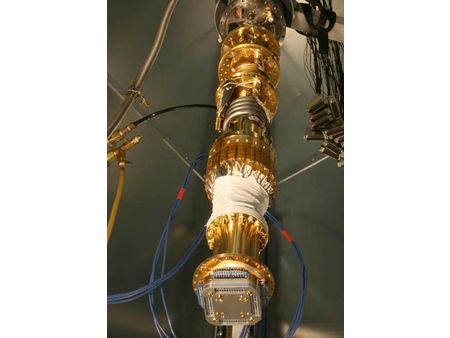Super-Cooled Quantum Computing Is Coming
D-Wave’s Orion: The First Commercial Quantum Computer?
Quantum mechanics describes how nature works at a fundamental level. Using those principles to build a quantum computer doesn’t just mean working at the nanoscale level; it also means keeping everything cold enough to see quantum effects. That’s why D-Wave runs its Orion system at a temperature 250 times colder than interstellar space.
Last year the company had a 16-qubit quantum computer that founder and CTO Geordie Rose claimed was the most powerful quantum computer ever built and the first ever to run commercially-relevant applications. This year it has 28 qubits, it can recognise photos of famous landmarks – and you might soon be able to use it over the Web.
That’s far ahead of most other quantum computing developments and D-Wave has managed it by using semiconductor manufacturing techniques and existing chip fabs instead of optical circuits, quantum dots, laser containment or other approaches requiring exotic manufacturing techniques. D-Wave is also working on the other half of the problem; the programming tools for writing applications that take advantage of what quantum computing promises to deliver.
Rose defines a quantum computer as “a machine that harnesses the language of nature at the most fundamental level to gain, in some cases, extremely impressive performance gains over conventional computers. Computers are constrained by the laws of physics; what you can do with information is no more than the laws of physics, when you operate at classical level. On a quantum computer, information processing is done on devices that obey the laws of quantum mechanics. These things can be very small and very cold, and they can be built out of exotic materials.”
Get Tom's Hardware's best news and in-depth reviews, straight to your inbox.
Current page: D-Wave’s Orion: The First Commercial Quantum Computer?
Next Page Cold Enough To Super Conduct-
LIKE A GLOVE!Reply
I WANT TO SEE THAT THING PWN SOME GAMES >< I KNOW A LITTEL OVER BOARD BUT I CANT DREAM CANT I? -
robertking82881 dam you beat me to 1st post ?> o wait that was me i just was to fast about posting i did not sigh in o well i cant prove it now but i know it was me >< LIKE A GLOVEReply -
robertking82881 oops i said a bad word dont report me >< any ways the 1st post was me i was to quick to sigh in and yes i have made 3 post so sue me. LIKE A GLOVEReply -
magicandy I still wish someone would explain exactly how quantum mechanics and quantum computers work. Do they actually defy the laws of physics or what? I didn't think that was possible.....Reply -
lucuis Very cool, i'd also like to see that pwn some games. However judging by what they say, it'll be very difficult to do if it's even possible.Reply
BTW what does it matter who got first post anyway? lol -
Quantum computers process information with the "electron pairing" effect they naturally operate with, meaning it operates in such a way when one of the 28 bits is "doing something", it affects other parts of the chip in such a way they "do the same thing" naturally...it has very deep implications because it would basically SCALE LIKE CRAZY....NATURALLY....we are still in its infancy w/ 28 QBits, i dont even immagine what is will be like with 512...1024....a Giga QBit.....a Tera Q Bit.... they would all scale naturally... whatever we an do now whit it will be done faster and better when wider versions of the chip come out, withought the need to re-coding i immagine (Totally different from the way we program now with the current multi-core chips needing special programming to take advantage of more resources).- my 2 centz.Reply
-
Quantum computers process information with the "electron pairing" effect they naturally operate with, meaning it operates in such a way when one of the 28 bits is "doing something", it affects other parts of the chip in such a way they "do the same thing" naturally...it has very deep implications because it would basically SCALE LIKE CRAZY....NATURALLY....we are still in its infancy w/ 28 QBits, i dont even immagine what is will be like with 512...1024....a Giga QBit.....a Tera Q Bit.... they would all scale naturally... whatever we an do now whit it will be done faster and better when wider versions of the chip come out, withought the need to re-coding i immagine (Totally different from the way we program now with the current multi-core chips needing special programming to take advantage of more resources).- my 2 centz.Reply
-
the last resort basically, a quantum computer does not have to do "work" to get an answer. The "work" it does involves electrons and atoms. The problem is, is that when the "computer" reads the atoms/electrons, they are destroyed. So, the data can only be read once. But as mentioned in the article, code cracking would be very easy, as the computer would only have to work with one atom. Basically, the future quantum computer will be able to crack any code, instantly.Reply
